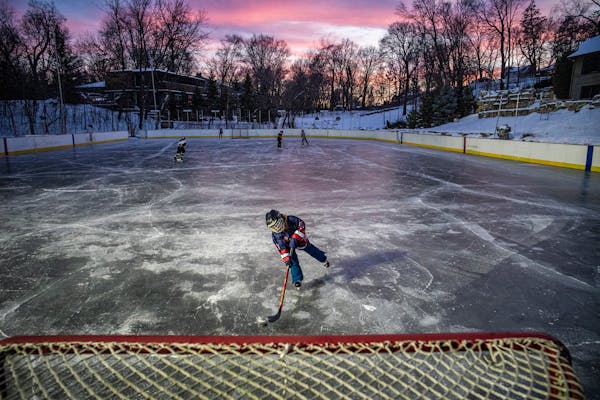Inside Minnesota's hallowed ice arenas — we have more of them than any other state — slapshots and axels may wow crowds. But the mundane work of the ice-resurfacing machine can be just as mesmerizing.
There's a nostalgic magic to the way the Zamboni slowly circles the rink, with a glistening sheen in its wake.
"It's winter in Minnesota," explains Don Olson, manager of the Hopkins Pavilion, the only ice rink in the state I've found that offers a "Learn to Drive the Zamboni" lesson.
So, not to brag, but I got to drive one.
And if you have a driver's license, you can, too.
Bucket list
Zambonis have led funeral processions and been miniaturized into Happy Meal toys for Canadian McDonald's. They shave off enough ice to make more than 3,000 snow cones per resurfacing.
The ingenious machines turn engineering into performance art — the icing on the ice of the arena experience.
But only a handful of rinks nationwide offer Zamboni driving lessons for novices. Visitors have come from nearly half the 50 states to learn in Hopkins, where sessions are available by appointment, Sept.–Feb. (Olson says he'll give a freebie to the first person to come from Hawaii.)
Recently, a woman flew in from Alaska to get behind-the-wheel experience for a potential job. But for most attendees, driving the Zamboni is a bucket-list item — a safer thrill than sky diving.
The pavilion offers 30-minute joy rides to drive the Zamboni out on the ice ($30). But most students choose its two-hourlong training session to actually resurface the rink ($120).
Jodi Brummer, the pavilion's assistant manager, says some people who book sessions are hockey fans who have criticized Zamboni drivers for missing a spot. Then their wives are like: You try to do it. "They want to see how hard it is — it's kind of a competitive thing," Brummer explained. Afterward, she added, "99 percent say they'll give the Zamboni driver a little lenience."
My lesson began with a video covering the basic mechanics of the ice-resurfacing machine, which is generically referred to by the dominant brand, Zamboni. Before California ice-rink owner Frank Zamboni patented his eponymous vehicle in 1953, the process took more than an hour and involved a tractor-pulled scraper and several shovel-and-squeegee-wielding workers.
My instructor, Keith Morehouse, the pavilion's maintenance supervisor, gave me a tour of the rink's primary machine, an electric-powered Zamboni they paid $135,000 for 10 years ago. (I waited to ask that question until after I'd driven it, not wanting to make myself any more nervous about crashing into the boards.)
In simple terms, the Zamboni washes the rink's surface, scrapes off the top layer, and then lays down a fresh layer of ice. All of this happens inside a long, flat implement on the back called a conditioner.
The wash components act sort of like a wet vac: spraying out water and sucking it back up, bringing along any ice shavings and debris. Then a massive blade slices a thin layer off the rink's surface and two augers carry the shavings into the giant snow bin under the Zamboni's hood. Finally, a sprinkler pipe dispenses hot water, spread evenly by a towel, to form a new layer of ice of about the same thickness as what was removed.
Behind the wheel
Morehouse had me climb into the Zamboni's seat, which is perched nearly as high as a cab in a semi. Aside from the steering wheel and pedals, not much looked familiar.
The Zamboni's instrument panel lacks a speedometer. (Its top speed is less than 10 mph.) And the stick used to put the Zamboni in gear was accompanied by a half-dozen other levers and rods used to engage the cleaning and ice-making components. There was also a small wheel for raising and lowering the blade, depending on how much abuse the sheet has taken. (High school hockey teams "really carve it up," Morehouse said.)
I backed the Zamboni onto the ice and Morehouse, standing on the conditioner, coached me through a few driving exercises. My first impression was how little visibility I had trying to see over the vehicle's massive nose, which dwarfed even that of my late grandmother's 1980s Lincoln Continental. "Rule number one is: Make sure no kids are on the ice," Morehouse advised.
The Zamboni's studded tires kept it from slipping as I lumbered down the center of the rink at roughly the speed of a kid learning to ride a bike. (Morehouse goes a little faster, but he's also been at this for more than three decades. And yes, he has long-since tired of hearing "(I Wanna Drive the) Zamboni" over the P.A.)
My first task was to drive clockwise around the rink's perimeter and, deploying a spinning brush that pops out from the driver's side, clean up the ice shavings along the boards. Leaning my head over the side to see better, I did a decent job following the straightaway.
At the corners, I couldn't help but pull away from the boards, for fear of bonking the front bumper. Experienced drivers develop a feel for the Zamboni's edges, like a cat knows its whiskers, and can corner mere inches from the boards. But even experts occasionally give them a "love tap," Morehouse admitted. (Fortunately, over the past decade, only one lesson-taker has ever done it.)
Next, Morehouse showed me how to take corners in the middle of the rink, and I found turning toward the machine's blind, right-hand side was even more difficult. I couldn't see where I was going and I had no instinct for handling, like I was driving a speedboat for the first time. I turned the wheel too soon. Then too tightly. Then not tightly enough. "The U-turns are really, really tough," Morehouse reassured me.
Making ice
Now it was time for my biggest challenge: making my own sheet of ice. Morehouse diagrammed the basic pattern. First, I'd drive clockwise along the rink's long left-hand side and then turn straight down the center to create an oval. I'd make each subsequent lap one machine-width to the right, following the seam between the "clean" and "dirty" ice.
The main thing to remember, Morehouse said, was to always keep the Zamboni moving forward. If you stopped, the towel could bunch up, the water could pool, and the blade could freeze to the ice and get the vehicle stuck. Yikes!
The other tricky aspect of operating the Zamboni, Morehouse explained, is that the driver engages the ice-making components by pulling the levers, in the correct order, while the machine is moving. (It helps if you are a person who can work the radio while driving.) I followed Morehouse's cues and the Zamboni started discharging a shimmering ribbon of water I only dared sneak a peek at for fear of steering off course.
I still struggled with corners and missed several spots, but Morehouse guided me through a few more passes to clean up my mistakes. "The more you do it, the better you get," my patient instructor said.
The last step, Morehouse explained, was to drive into the garage and pull one final lever. The Zamboni's hood opened and the giant snow tank underneath it lifted up like a dump trunk. A huge mound of snow slid into a grate in the floor.
Though I had picked up the basics of Zamboni-driving fairly quickly, I could tell that mastering the steering and fine-tuning the nuances of ice-making — accounting for variations in thickness, temperature and learning "how to read the sheet," as Olson put it — would take time.
If I wanted to do so, I would need to get going, Olson noted, as Zamboni driving will likely become a lost art when autonomous resurfacing machines come online.
I looked out over the empty rink, where the 150-some gallons of water I'd spread had lacquered its surface with a lustrous coat. The sense of satisfaction felt like making a bed with crisp white sheets, but on a grander, godlike scale, almost like I had taken control of the heavens and deposited a blanket of pristine snow.
If only I'd brought my skates.

Never mind the oldies — here are 10 younger acts to see this summer in Minnesota

Review: Conrad Tao delivers a thrilling Beethoven piano concerto with the Minnesota Orchestra

Gen Z jazz singer Laufey is headed to Target Center on Oct. 11

